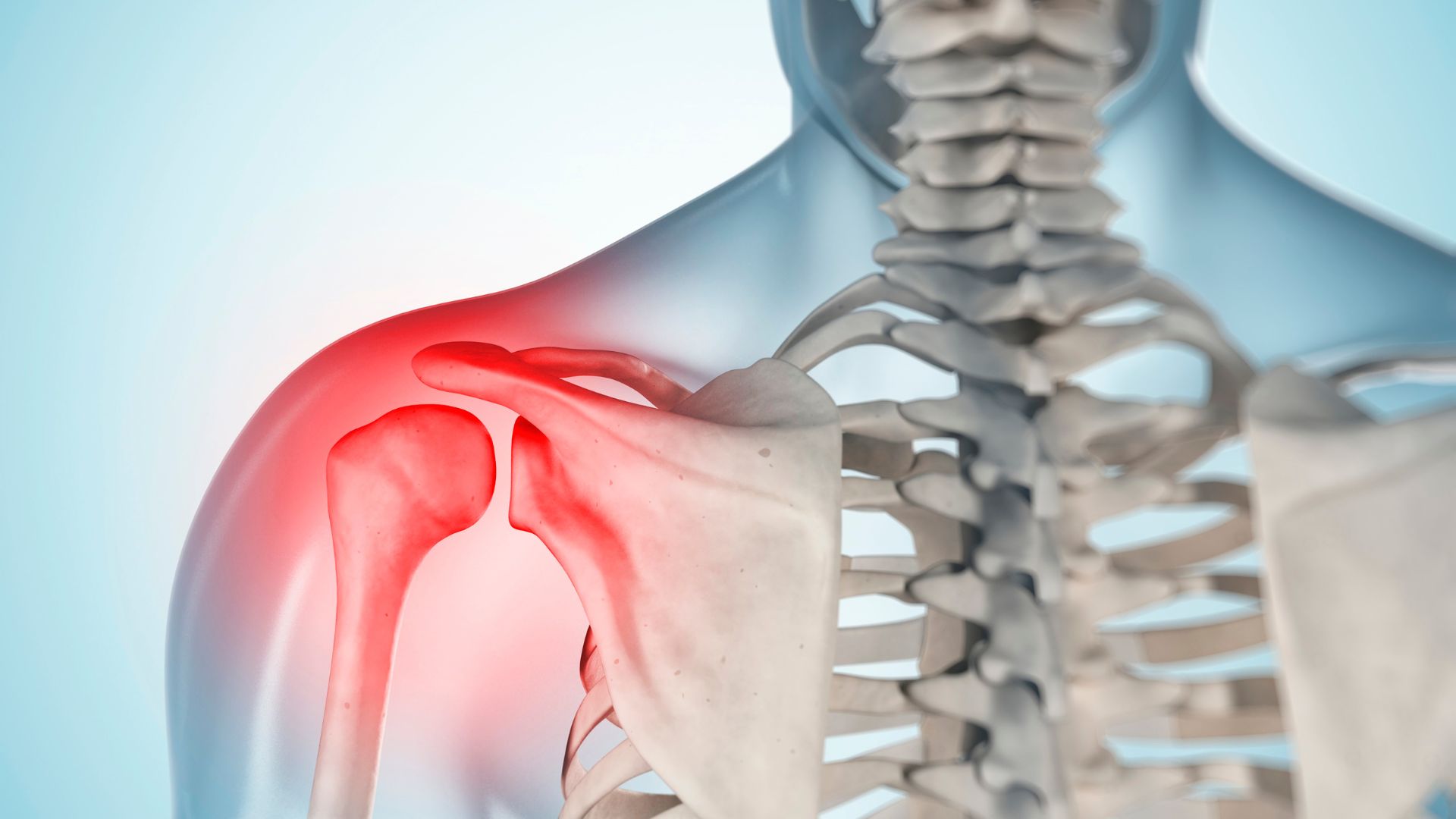Shoulder Pain Treatment in Singapore
October 29, 2025
Shoulder pain can disrupt daily activities such as reaching overhead, carrying bags, or even sleeping comfortably. For many people in Singapore, shoulder pain is more than a minor annoyance; it can affect work performance, limit exercise, and reduce overall quality of life.
The good news is that many shoulder conditions can now be accurately diagnosed and managed using minimally invasive techniques that relieve pain and restore function without major surgery.
At Singapore Paincare, our specialists use the proprietary Painostic® diagnostic system to identify the root cause of your pain and customise safe, targeted treatments that help you move comfortably again.

Understanding Shoulder Pain
Common Causes of Shoulder Pain
Shoulder pain can stem from injuries, overuse, or natural degeneration over time. Common conditions include:
- Shoulder Rotator cuff tendinitis or tears: Inflammation or injury affecting the shoulder tendons, often causing pain when lifting or reaching.
- Frozen shoulder (adhesive capsulitis): Stiffness and aching that gradually lock up shoulder movement.
- Shoulder impingement syndrome: Tendons get pinched during overhead activities, creating sharp or catching pain.
- Bursitis: Swelling of the small cushioning sacs around the joint leads to soreness and restricted motion.
- Shoulder Arthritis: Long-term wear in the joint that brings on stiffness and persistent discomfort.
- Shoulder Girdle Syndrome: A rare neurological condition also known as neuralgic amyotrophy. It causes sudden shoulder pain without injury followed by weakness in specific muscles such as the deltoid, supraspinatus and infraspinatus, and sometimes the levator scapulae and rhomboids.
- Shoulder Sprain: A stretch or injury to ligaments around the joint that causes pain after a fall, twist or sudden movement.
When to See a Doctor for Shoulder Pain?
See a doctor if you have:
- Shoulder pain that persists for several days despite rest or over-the-counter medication.
- Weakness, swelling, redness, or visible deformity in the shoulder.
- Shoulder pain after a fall, injury, or trauma.
- Difficulty lifting, rotating, or using your arm normally.
Seek emergency care immediately if your shoulder is deformed or pain follows a major fall.
How Shoulder Pain is Diagnosed?
Diagnosis typically begins with a detailed clinical assessment and may include imaging tests. These help identify whether the pain arises from muscle, tendon, joint, or nerve structures. Common imaging tools include:
- Ultrasound – quick, cost-efficient, and accurate for assessing soft tissues and tendons.
- MRI – used for deeper or more complex shoulder injuries.
The Painostic® Approach at Singapore Paincare
At Singapore Paincare, our pain specialists uses Painostic® approach that goes beyond scans and X-rays. They combine medical history, posture analysis, pain mapping, and movement testing to determine whether your pain originates from muscles, tendons, joints, or nerves. By looking at the full picture — including lifestyle habits and how pain affects your daily life — our doctors deliver a truly individualised diagnosis.
Our pain specialists assess five key aspects of each case: pattern, pathology, perception, psychology, and treatment goals. This detailed evaluation allows them to create a personalised care plan tailored to your unique needs.
Treatment is guided through structured, precision-focused protocols that ensure accuracy and effectiveness: thorough diagnostic assessment, targeted pain management planning, and precise delivery of treatment to the affected area.
This holistic and minimally invasive approach helps patients recover faster, reduces the need for unnecessary surgery, and ensures every step of care is transparent and clearly communicated.
What are Shoulder Pain Treatment Options in Singapore?
Treatment for shoulder pain depends on the cause, severity, and your individual needs. Common options include:
Conservative Treatments
- Rest and activity modification – avoiding movements that trigger pain.
- Physiotherapy – exercises to restore strength, flexibility, and range of motion.
- Medications – anti-inflammatory or pain-relief medications to manage discomfort.
- Heat or cold therapy – reduces inflammation and soothes sore muscles.
Minimally Invasive Treatments for Shoulder Pain

For persistent pain or structural injury, targeted procedures can treat the pain source while avoiding open surgery. At Singapore Paincare, we offer a range of minimally invasive treatments that relieve pain precisely at its origin.
Myospan Injection
Myospan injections target muscles, ligaments, tendons, joints, and nerves to break the pain cycle, reduce inflammation, and improve healing. Depending on the painful condition, different injections may be utilised to either remove the pain generator or stop the pain signals. Myospan treatments include:
- Coreflex injections: Coreflex injections combine local anaesthetic, anti-inflammatory medication, and muscle relaxants to reduce muscle spasm and inflammation. They are commonly used for soft tissue injuries, tendon irritation, and shoulder impingement.
- Platelet-Rich Plasma Prolotherapy: PRP Prolotherapy uses concentrated platelets from the patient’s own blood to stimulate tissue repair. The injection creates a controlled, low-grade inflammatory response that promotes healing of tendons and ligaments.
- Intra-Articular Injections: These injections deliver medication directly into the shoulder joint to reduce pain, inflammation, and stiffness. They may contain anti-inflammatory agents or hyaluronic acid to improve joint lubrication and mobility.
- Myofascial Pain injections: Myofascial injections target tight or knotted muscle bands that cause local and referred pain. The treatment relaxes contracted muscle fibres, flushes out irritating chemicals, and restores normal muscle function.
- Peripheral Nerve Block: A peripheral nerve block involves injecting local anaesthetic and anti-inflammatory medication around a specific nerve or nerve bundle. This temporarily interrupts pain signals and provides relief for nerve-related shoulder pain.
Neurospan
Neurospan treatments target spinal causes of shoulder-related pain such as slipped cervical discs, bone spurs, and nerve compressions. These procedures help decompress affected nerves, release scarred tissues, and reduce nerve sensitivity by addressing the underlying spinal source rather than the shoulder itself. Depending on the condition, different Neurospan options may be used to free impinged nerves or reduce pain transmission. Neurospan treatments include:
- Neuroplasty: Neuroplasty involves inserting a soft catheter into the spine to create more space around the affected nerve. The procedure breaks down adhesions and delivers medication to reduce inflammation and nerve irritation.
- Nucleoplasty: Nucleoplasty uses controlled energy to remove a small portion of the nucleus within a herniated disc. By reducing disc pressure, the treatment helps relieve compression on nearby nerve roots.
- Radiofrequency Ablation (RFA): RFA applies heat generated by radiofrequency energy to targeted nerves. This disrupts pain transmission and reduces inflammation in the facet joints, providing longer-lasting relief.
- Pulsed Radio Frequency (PRF): PRF delivers short bursts of radiofrequency energy to calm hypersensitive nerves without destroying them. It is used for nerve-related shoulder pain that does not require full ablation.
- Spinal Cord Stimulator: A Spinal Cord Stimulator is an implantable device that sends gentle electrical signals to the spinal cord. These signals modify how pain is processed before it reaches the brain, helping reduce chronic nerve pain.
Surgical Treatments
Surgery is rarely required. It may be considered if there is severe structural damage or failure of other treatments.
- Arthroscopic repair – for severe rotator cuff tears or persistent joint issues.
- Joint replacement or reconstruction – in advanced arthritis or irreparable joint damage.
Why Choose Singapore Paincare?
Minimally Invasive Pain Relief
At Singapore Paincare, our shoulder pain specialist, brings extensive experience in precision-guided, non-surgical techniques designed to target shoulder pain at its source safely and effectively — helping you recover with minimal discomfort and downtime.
The Painostic® system
Our Painostic® Approach designed to uncover the true source of pain. Rather than focusing only on scans or X-rays, this method looks at your complete picture: your medical history, posture, lifestyle habits, and how your pain behaves in daily life.
Pain can be complex. Sometimes, scans appear normal even when discomfort is real, or visible findings do not explain what you feel. The Painostic® framework helps our doctors make sense of these situations by distinguishing between:
- Functional pain – related to nerves, muscles, and movement
- Structural pain – linked to joint, bone, or tissue changes
Our specialists study five key aspects — pattern, pathology, perception, psychology, and treatment goals — to create a diagnosis that is truly individualised.
From there, the Painostic® process guides your care using three structured clinical protocols:
- Diagnostic Formulation – a thorough, multi-angle assessment of your pain experience.
- Injection Roadmap – a clear, step-by-step plan for targeted pain management using clinical feedback and precision tools.
- Injection Technique – a refined procedure that ensures medication is delivered accurately to the affected area.
This approach supports personalised and minimally invasive treatments, helping patients recover faster while avoiding unnecessary surgery whenever possible. Throughout the process, our doctors keep you informed and involved, so every step of care is clear and confident.
FAQs About Shoulder Pain Treatment in Singapore
Q1: Do I need an MRI for shoulder pain?
Not always. Many shoulder pain cases can be diagnosed using ultrasound combined with physical assessment.
Q2: Is the treatment Medisave-claimable?
Certain shoulder pain procedures may be Medisave-claimable depending on MOH regulations and individual assessment. Our staff can advise on eligibility.
Q3: How many injections will I need?
It depends on your shoulder pain condition. Some patients improve after a single injection, while others may require a short course for optimal results.
Q4: When should I go to the emergency department?
If shoulder pain follows an accident, the shoulder looks deformed, or you cannot move your arm, seek medical care immediately.
Take Control of Your Shoulder Pain
Don’t let shoulder pain interfere with your life. Whether caused by frozen shoulder, tendon irritation, or overuse, proper diagnosis and a minimally invasive plan can help you regain comfort and mobility.
👉 Book your consultation today to discuss your symptoms and learn about personalised, minimally invasive options that suit your needs.
